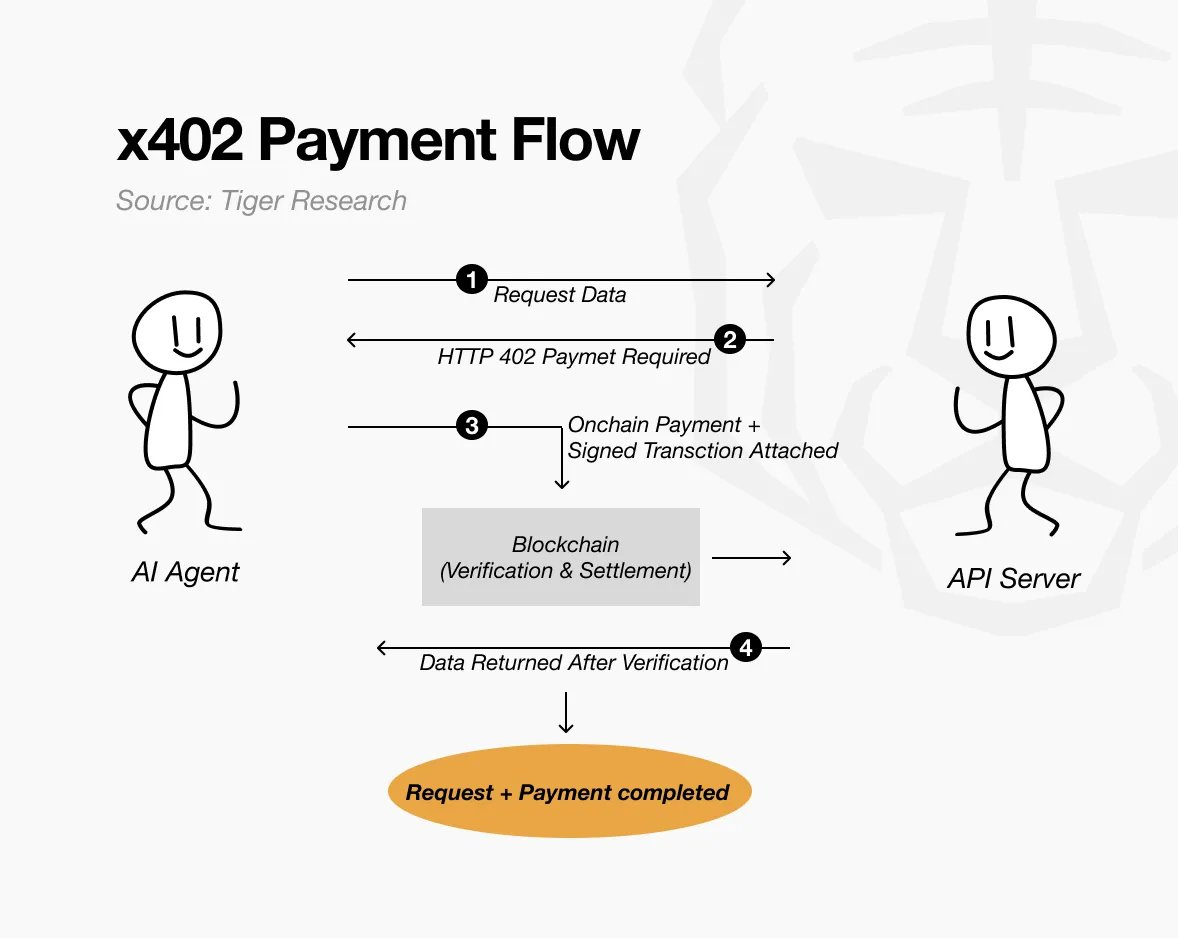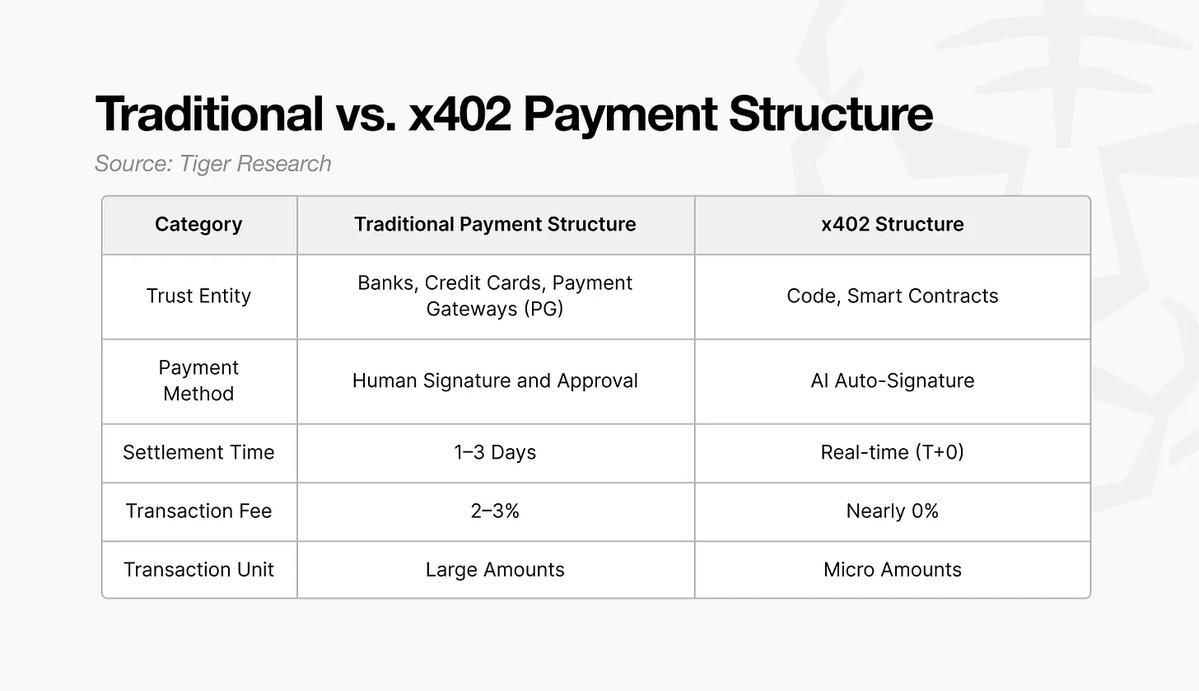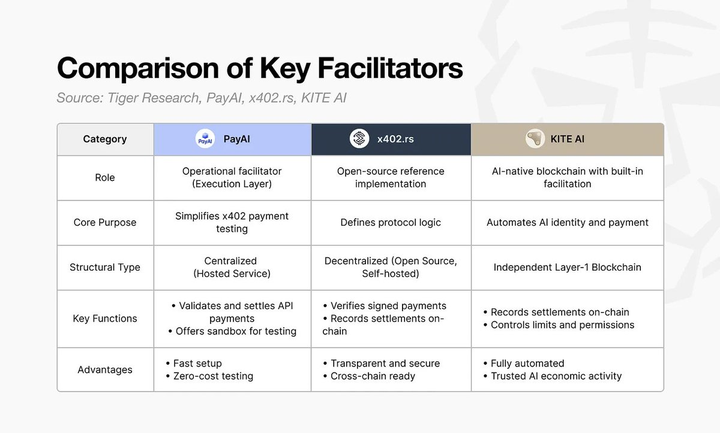Author: Tiger Research
Translation: Glendon, Techub news
Few people truly know that the often misunderstood project "x402" is developed by Coinbase. This article will analyze its role in Coinbase's strategy and its significant implications in the era of AI agents.
Key Points
x402 (a proposed standard for autonomous AI agent payments) is becoming a key topic in the integration of Web3 and AI;
Coinbase and Cloudflare jointly established the x402 Foundation to propose the concept and set early development standards;
Early promoting projects like PayAI, x402.rs, and KITE AI are gaining increasing attention for potentially implementing the protocol.
Recently, market focus has shifted to x402. The token prices of related projects have skyrocketed, and the on-chain transaction volume processed through the x402 protocol has increased more than 20 times in just one month. However, it is little known that the concept of x402 was proposed by the x402 Foundation, co-founded by Coinbase and Cloudflare.
So, what exactly is x402? It is a protocol standard that enables AI agents to autonomously complete payments without human approval. Currently, all AI services, including ChatGPT, face a structural limitation: they cannot independently complete transactions because payment authorization still requires human intervention. The x402 standard aims to eliminate this barrier, allowing AI agents to make verifiable, secure, and permissionless payments directly on-chain.
Origins of x402
In the era of AI agents, users will no longer browse the web directly; instead, AI systems will autonomously collect, interpret, and execute information. The primary consumers of internet content will shift from humans to machines—this structural change challenges the foundations of the current web economy.
Today's web relies on human-driven traffic and advertising: users visit websites, view ads, and generate revenue to sustain the creator ecosystem. But when AI agents replace human browsing, advertising will lose its direct audience, and this model will collapse.
Therefore, the internet needs a new type of value and payment structure suitable for machine-to-machine interaction.

The anticipated model is one where AI systems achieve automated, micro-payments with content providers. For example, an AI assistant might pay $0.03 to access a research paper for sleep analysis, or $0.15 to call an API for genetic data—without user registration, subscription, or manual approval. Content creators are compensated based on usage, while AI seamlessly acquires the data it needs.
To make this model work effectively, payments must be made automatically and autonomously, without human intervention. The current financial system cannot support this, as every transaction still requires user authentication or approval.
Interestingly, x402 is becoming the infrastructure for this future payment. It aims to establish a set of standards that allow AI agents to independently conduct transactions, compensation, and value exchange within the Web3 economy.
x402 Foundation: The Integration of Protocol and Infrastructure
Although x402 was initially developed by Coinbase, the company partnered with Cloudflare to establish the x402 Foundation, aiming to extend the protocol to a broader internet domain. This collaboration raises an important question: why would Coinbase, a cryptocurrency-native company, partner with a global network infrastructure provider?
The answer lies in the design philosophy of x402. Its goal is to embed payment logic directly into the foundational layer of the web (HTTP)—essentially integrating transaction functionality into the core architecture of the internet. To achieve this, a protocol-level system needs to be supported by infrastructure that has global coverage, low latency, and can handle network-level traffic.
Cloudflare provides just such infrastructure. The company has deployed servers in over 120 countries and operates one of the largest real-time traffic relay and cybersecurity networks globally. In this collaboration, Coinbase is responsible for designing the payment protocol, while Cloudflare ensures its stable operation in real-world network environments.
Another noteworthy development is Cloudflare's upcoming stablecoin, NET Dollar. While the current x402 white paper lists USDC as the primary settlement token (due to its regulatory stability and liquidity), Cloudflare's entry into the stablecoin space suggests strategic synergy. If NET Dollar integrates with x402, Cloudflare could connect its global network infrastructure directly with web-based payment channels, expanding its role from a traffic provider to a payment provider.
How x402 Works

The x402 protocol defines a payment process that allows AI agents to autonomously complete transactions without human intervention or intermediaries. The following example illustrates its operational sequence:
An AI agent requests access to sleep-related research papers from an online publishing platform to optimize its sleep analysis model.
The platform returns an HTTP 402 "Payment Required" message, along with key information: the required payment amount, the blockchain network used, and the transaction parameters needed to process the payment.
The AI agent automatically executes the payment based on the provided data, signs the transaction, resubmits the request, and includes the on-chain transaction proof.
The platform verifies the transaction on the blockchain and delivers the requested content to the AI agent upon confirmation.
Through this process, x402 replaces traditional intermediaries in the payment chain, enabling AI agents to independently complete transactions, authenticate identities, and access digital resources.
Differences Between x402 and Traditional Payment Systems: A Paradigm Shift from Humans to Code
Traditional payment systems have always relied on banks and credit card companies as central intermediaries. When users click the "Pay" button, financial institutions authorize the transaction—this approval serves as a guarantee of the payment's legitimacy and security.
In the x402 framework, intermediaries will no longer exist. After the AI agent sends a payment request, the server automatically completes the verification through smart contracts. Authorization, settlement, and verification are all executed programmatically, shifting the trust foundation from humans and institutions to code.

Traditional payment processors like Stripe or PayPal still require human involvement—users must create accounts, verify identities, and manually approve transactions. For AI agents that need to interact with hundreds of services, this reliance on human intervention becomes a major limitation.
x402 eliminates these barriers in the network environment. Payment data is directly embedded in the request header, allowing AI agents to autonomously complete transactions through their on-chain wallets, achieving machine-to-machine transactions without subscriptions, manual logins, or external approvals.
The key difference is not only the speed increase but also a structural shift in the way trust is verified. In x402, trust is expressed in code: smart contracts handle authorization, settlement, and payment proof, with humans only needing to review the final results. The validity of transactions is no longer guaranteed by financial intermediaries but is secured by protocol rules and blockchain records, establishing a decentralized, intermediary-free payment framework.
Designed by Coinbase, x402 acts as a "language of the web"—a framework through which AI can autonomously act, transact, and access data. As the protocol gains traction, the fundamental behavior of the internet may evolve from "searching" to "paying," marking a paradigm shift of the internet towards an AI-driven digital economy.
x402 Ecosystem
Even if AI agents can autonomously complete payments, a coordinating layer is still needed to prevent errors, duplicate payments, or inconsistent executions. This function is fulfilled by Facilitators (coordinating nodes)—acting as intermediary nodes that verify payment conditions and manage settlements between AI agents and service providers. In the x402 network, coordinating nodes form the trust and execution layer that maintains transaction integrity.
Currently, there are multiple coordinating nodes (payment service providers) in the x402 ecosystem, with Coinbase dominating the market with about 70% market share, followed by PayAI Network and x402.rs, each holding about 10% market share. Additionally, another emerging participant supported by Coinbase's investment, KITE AI, is also beginning to attract market attention.

PayAI: A Practical Entry for Developers
PayAI (@PayAINetwork), as an operational coordinating node, allows developers to experiment with x402 payments without building complex infrastructure, essentially providing a "sandboxed" environment for real-world scenario testing.
Its operational process is as follows: when a developer sends a request to a paid API, the server returns detailed information, such as the required payment amount, blockchain, and token type. Then, PayAI verifies the transaction, processes the settlement, and returns the confirmation result to the developer.
The main advantage of PayAI is its low entry barrier. It automatically refunds payments sent to its Echo Merchant testing environment and even covers network fees, allowing developers to simulate real payment processes with zero risk.
However, this design also has limitations. Since PayAI centrally handles all verification and settlement, any operational failure could lead to a complete system outage. For large-scale deployments, redundancy and verification mechanisms need to be increased, such as cross-verifying through multiple coordinating nodes or implementing a decentralized settlement layer to ensure reliability.
x402.rs
x402.rs serves as a technical blueprint, demonstrating how coordinating nodes operate within the x402 framework. This open-source project is written in Rust, allowing anyone to review, modify, and build their own coordinating system based on the standards.
Its workflow is as follows: when the server issues a payment request, the client resends the request with a signed payment payload. x402.rs verifies the data integrity (ensuring it has not been tampered with) and subsequently records the settlement transaction on-chain.
The main advantage of Rust lies in its transparency. Its verification and settlement logic is completely open, facilitating integration with external systems. The powerful memory safety and high-performance features of the Rust language also make it particularly suitable for high-security, high-throughput environments.
However, it is important to note that x402.rs is a foundational framework rather than a complete production system. Actual deployment requires additional components such as network reliability management, retry mechanisms, and transaction tracking. The currently supported blockchains and functionalities are limited to the basic modules necessary to demonstrate the core behaviors of the protocol.
KITE AI: An AI-Specific Chain Integrating Identity and Payment Functions
KITE AI (@GoKiteAI) is an independent blockchain specifically designed for AI agents. Unlike other platforms that operate as middleware, KITE AI embeds coordination and verification functions directly into the blockchain layer, thereby building a trusted infrastructure for autonomous transactions between AIs.
The architecture of KITE AI revolves around three core components:
Agent Passport: An on-chain digital identity issued for each AI agent, recording ownership, operational purposes, and transaction permissions;
Session Keys and Spending Limits: Built into the passport and automatically managed by smart contracts, ensuring that AI agents cannot execute unauthorized payments or exceed limits;
Trusted Interaction Framework: When an AI uses a service or purchases data, it authenticates its identity through the agent passport. Once payment is approved, the transaction is immutably recorded on-chain.
Essentially, the agent passport enables AI agents to act autonomously while maintaining verifiable identity, permissions, and spending controls. This architecture lays the foundation for a secure and accountable AI economy.
The core advantage of KITE AI lies in the automation at the protocol level. Authentication, authorization, payment execution, credential verification, and even dispute resolution can be seamlessly completed without human intervention. By embedding protective mechanisms such as session keys, spending limits, and reputation tracking directly into the blockchain, KITE AI also provides built-in safeguards, making autonomous AI transactions both secure and auditable.
The Starting Point for an Internet Where AI Can Autonomously Consume
x402 is still in its early development stages. The concept of a machine-to-machine economy (M2M)—where AI agents autonomously pay and transact—currently remains largely theoretical. Existing transactions are limited to testing phases, with only a few early partners involved. Core elements such as payment stability, security, and legal clarity have yet to be established, and the entire ecosystem is essentially testing whether AI can become an independent economic entity.
However, the direction of development is clear: embedding payment capabilities into the HTTP protocol is redefining the internet from an information network to a value network, enabling machines to engage in native economic activities. Although Coinbase initiated the x402 project, its development work is now being advanced collectively by the entire ecosystem. Ethereum's ERC-8004, along with institutions like Google and Claude, are integrating the protocol, and other participants are experimenting with new coordinating node models. Coinbase is now just the starting point, not the owner.
Just as the development of stablecoins faced skepticism in its early stages, the widespread adoption of x402 remains uncertain. However, as more participants conduct tests and improvements, the vision of an AI-driven transactional internet is gradually becoming a foreseeable reality.
免责声明:本文章仅代表作者个人观点,不代表本平台的立场和观点。本文章仅供信息分享,不构成对任何人的任何投资建议。用户与作者之间的任何争议,与本平台无关。如网页中刊载的文章或图片涉及侵权,请提供相关的权利证明和身份证明发送邮件到support@aicoin.com,本平台相关工作人员将会进行核查。




